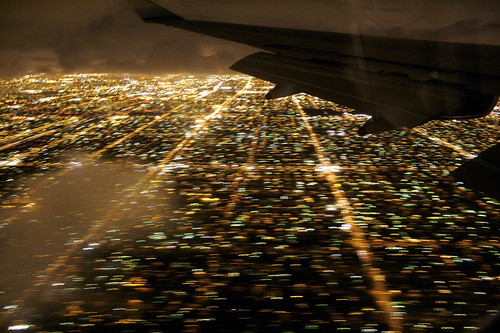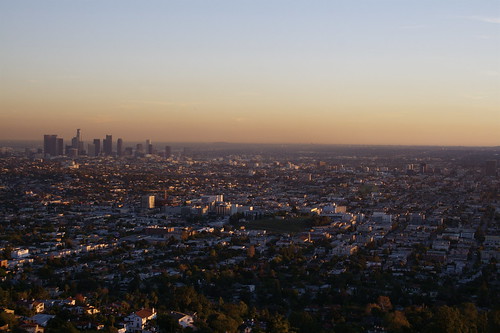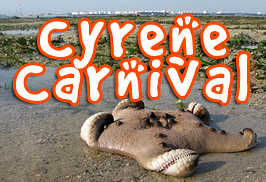
View of Los Angeles from the plane landing at LAX
It's been 26 days since the monkey checked in with her daily green action. Despite having been back in Singapore since Sunday, almost a week ago, I've been struggling to keep up with school, work and friends. Blame it on jet lag or just culture-lag but I'm trying to adjust back to regular programming again.
Can't say I have been particularly green while in Suburbia San Diego. It was particularly difficult and frustrating. Just about the only positive thing I noticed is that the toilet paper used is particularly environmental while back home, thick luscious toilet paper makes me cringe at the thought of virgin pulp. And honestly if I have to resort to comparing toilet paper, you know there hasn't been much else to focus on. Environmentally, of course.
While I haven't been exactly shopping my days away, drowning myself in materialist consumerism, it was particularly frustrating to drive from strip mall to box mall. Living in a suburban sprawl, visiting the sites where the San Diego fire has taken its toll, looking at burnt slopes made it very difficult for my sense and sensibilities.
Suddenly, visiting downtown Los Angeles felt like a reprieve and haven despite the fact that I've always hated it. I realize it's not the city itself that was unsustainable but the urban sprawl in the greater LA county and its commuting culture in said suburban sprawl that was critiqued. 
The Lost Angels and its sprawl can be seen very clearly in this photo taken from Griffith Observatory near the Hollywood sign. Photo taken on the 2007 Winter Solstice.
Within the city itself, it was really much better in terms of walking, public transport and even mixed use housing! Unfortunately, my friend who is a LA county planner informed me that it's very much gentrified within the downtown area now. Read: expensive housing for rich executives. Pretty much the same as Singapore's downtown area I suppose.
Perhaps it is due to Singapore's space constraint that we have planned our land much better. However, this nagging thought will always lingers at the back of mind if Singapore had the land, would we also be crying out for single-family residence with a backyard for the kids and dog? In Singapore, owning a landed property is very much a status symbol. If more houses and land were available, surely we will all be scrambling for one. Sadly, who would want to live in high rise buildings then?
Perhaps after 2 generations of living in highrise apartment buildings, we have lost the call of the land. While it has disconnected us from nature, at the same time I doubt the suburban dwellers in san diego are very much more connected to nature. It's all a dilemma for me.
I tried to argue that nature should be kept apart from cities. Despite my love for nature, I rather live in the city. Not because I love living in cities. In fact, I abhor cities. However, if it means keeping myself from encroaching on wilderness, nature reserves and other rural or "wild" spaces, I would gladly suffer it.
How many people would be willing to do that? Not many I would think. If given the choice we all want the peaceful, tranquil, close to wild open spaces for our kids to run freely. I wouldn't want to raise a kid in New York City for example. It's really a headache thinking about these questions.
Yet watching the news in San Diego about cougars (mountain lions) running into the suburban towns in California made me toughen my resolve. There is a difference between living in the suburban area and living in a suburban SPRAWL. I think the motivations of planners and developers, population wanting to serve their own desires and crazy monkeys like me who cares more about the environment than my own desires are wildly different.
In Singapore, we don't have much say about suburban sprawl. In fact, we have sprawled beyond control. Jurong West extension, Punggol 21, were they not all "wilderness" before? The government says we need land for housing and goodbye mangroves and forests. Private developers (and the government that allocates land to them) continue to encroach on the Bukit Timah Nature Reserve with condominiums at the edge of the forest. Likewise, the selling point of these developments is to be "close to nature". Yet how many of these Bukit Timah residents complain about snakes coming into their homes? I know a few. Another case in point of the cougars.
So are we much different from the sprawl in US or any other countries? My only consolation perhaps is that our planning applied the key features of the new urbanism concept which is to have things within walking distance and to reduce car use and building a sense of community. Well, it's debatable. Besides there have been critiques who thought that Singapore may do a better job at conservation if we never build satellite towns scattered around the island but focused on growing the city in one concentrated space.
Do we ever think about what we are doing to satisfy our selfish desire to be "close to nature"? While we love nature, do we want to destroy nature just for us to have a piece of it? Or should we "sacrifice" our selfish desire and suffer the urban populace so that we can still have a piece of nature to go enjoy on the weekends?
And that is my monkey land dilemma and honestly I still do not know what the "right answer" is. Nor so I have an answer for myself. What do you think?
Saturday, January 12, 2008
The Monkey's Land Dilemma
Posted by
Monkey
at
Saturday, January 12, 2008
![]()
Labels: Environment, Nature, Planning, Travels

 I can be contacted at
I can be contacted at 







5 comments:
I too find Singapore's neighbourhoods very similar to US suburban sprawl. The only difference is that instead of big houses with lawns, we have blocks of cramped apartments. Other unpleasant aspects of suburban sprawl are imported over, though. In the newer towns, there are no longer any small convenience stores at the ground level of HDB blocks. Instead, the emphasis is on building a glitzy mall somewhere in each town and forcing residents of the town to head to the mall for even the most minor errands. Furthermore, car use is heavily favoured (for all that they pay lip service to public transport). Go to a new town like Punggol and you'll notice that there are still large swathes of empty fields. It'll be at least a few years before people will be living there. Yet these fields are already surrounded by huge three-lane (in both directions) roads, which are almost empty all the time. In short, roads are built way ahead of demand. Once a big road is built, no one is going to tear it up if they find out that it's not necessary. So building a large road practically makes it a certainty that people will build surrounding structures so as to justify the existence of the road. I find the consequences of such road-directed planning most unpleasant.
Furthermore, the pattern is to build a few very large arterial roads with fast-moving traffic, so that road users have to use certain roads to get to certain places. For example, there are very few routes into Toa Payoh that don't involve using either an expressway or a flyover with fast-moving traffic. Pedestrian crossings are few and far between, and crossing the big roads often involves a long wait at a polluted, busy junction. In most cities in the US that I have been to, the roads were much smaller and in a very dense grid network, so there were plenty of alternative routes available. Crossing roads was easy and relatively pain-free compared to in Singapore. Cycling, too, was less dangerous as traffic was less fast and there were less flyovers and expressway, the filters of which are routinely points of terror for cyclists in Singapore. In short, Singapore's suburban roads (like US suburban roads, and unlike US cities) provide strong disincentives to walk or cycle. This leaves either driving or public transport. Unfortunately, the train network is sparse for a city of our size. The buses are slow because of the sheer volume of cars. Yeah, yeah, the buses and trains are clean and efficient, and so on. But I'd trade our current cleanliness for the station density of London's Tube (for example). I'd put up with the occasional strike and dirty seats for a more comprehensive coverage. Until we drastically reduce the number of cars on the road, having more buses is not going to significantly decrease travel times.
In any case, I don't think people who live in places like Bukit Timah really want to be 'close to nature'. I think that they instead like the idea of being away from the cramped quarters of other parts of the city. However, just walk past the private housing outside Bukit Timah and you can see that all their windows are always shut tight. They probably use air-conditioning. How much of nature do they really experience? Of course, it's convenient for those who visit the nature reserve, but as you pointed out, you can perfectly well live in the city and visit nature. I suspect these people are similar to US suburb residents --- they want to be away from the hustle-and-bustle of the city, but ultimately they still lead a life isolated from nature --- they close their windows and drive everywhere.
excellent points! thank you!
I absolutely agree with you. especially with the latest trends for malls. i didn't want to rant about it in my post but one of my biggest gripe are the strip malls. how we have to depend on the big brands instead of mom and pops.
although i live in a neighborhood without shops downstairs, i have an old style shopping centre.
but seriously these mom and pops are at a decline. people prefer malls. its the call of consumerism.
my parents own a small retail shop in one of the 80s/90s-style "town center" areas connected to the flats. However, business is so horrid and there is A LOT I can write about this but it's hard to fight against the malls.
and yep i totally agree about the Bukit Timah residents.
Likewise, people choose to live in suburbs not because they want to be close to nature! just to be away from the city. I didn't include that bit but was mainly thinking about the advertising for the condos at the FOOT of BTNR like "the rainforest" or whatever. they want to be "close" but at a distant and yes, aircon aircon. sigh
and regarding the road-oriented construction, think about it this way - if i build a one lane road first and then having to expand a few lane at a time over the next 20 years, that would be bad too.
still i agree that because of the planning of the satellite towns, the only way to get to these towns are by expressway. but toa payoh used to be better from what i know till the PIE cut across it and took out a lot of the little roads.
sigh anyways its such a problematic thing but i really thank you for the long comment. very encouraged :)
Great story! I agree - we need to think globally and environmentally when we build in the future.
Great essay, November,
The subject of human encroachment is well-explored and thought-provoking. The motive of living in the city core and leaving nature sprawl a'sprawling sit well with my own thinking. But it is hard to think about long term when in the immediacy of current landuse, you see developments encroaching ever closer to nature corridors. This is compounded by the projected 6 million population that our gorvernment is thinking of implementing. Crazy - that's what I think.
I have written about mandai. Hope yo have the chance to sit down to digest it. It touched on human encroachment too; not to mention - encroachment of the mind with bad education.
http://www.eart-h.com/text/mandai.htm
Well, wishing you a happy new year, and study well.
Joe Lai
thanks for the comment dharma design and joe! glad there are other nature lovers who do not think it contradictory to want to live in the city for the sake of not being a sprawler.
i think a lot of time, it's not just about the planners but the consumers need to be making the right choice as well! case in point bukit timah and yes, mandai as well!
speaking of which, the monkey mind is brewing up another article about community building, green buildings, eco city and new urbanism but meanwhile working on with my right brain on changing blog design lol
Post a Comment